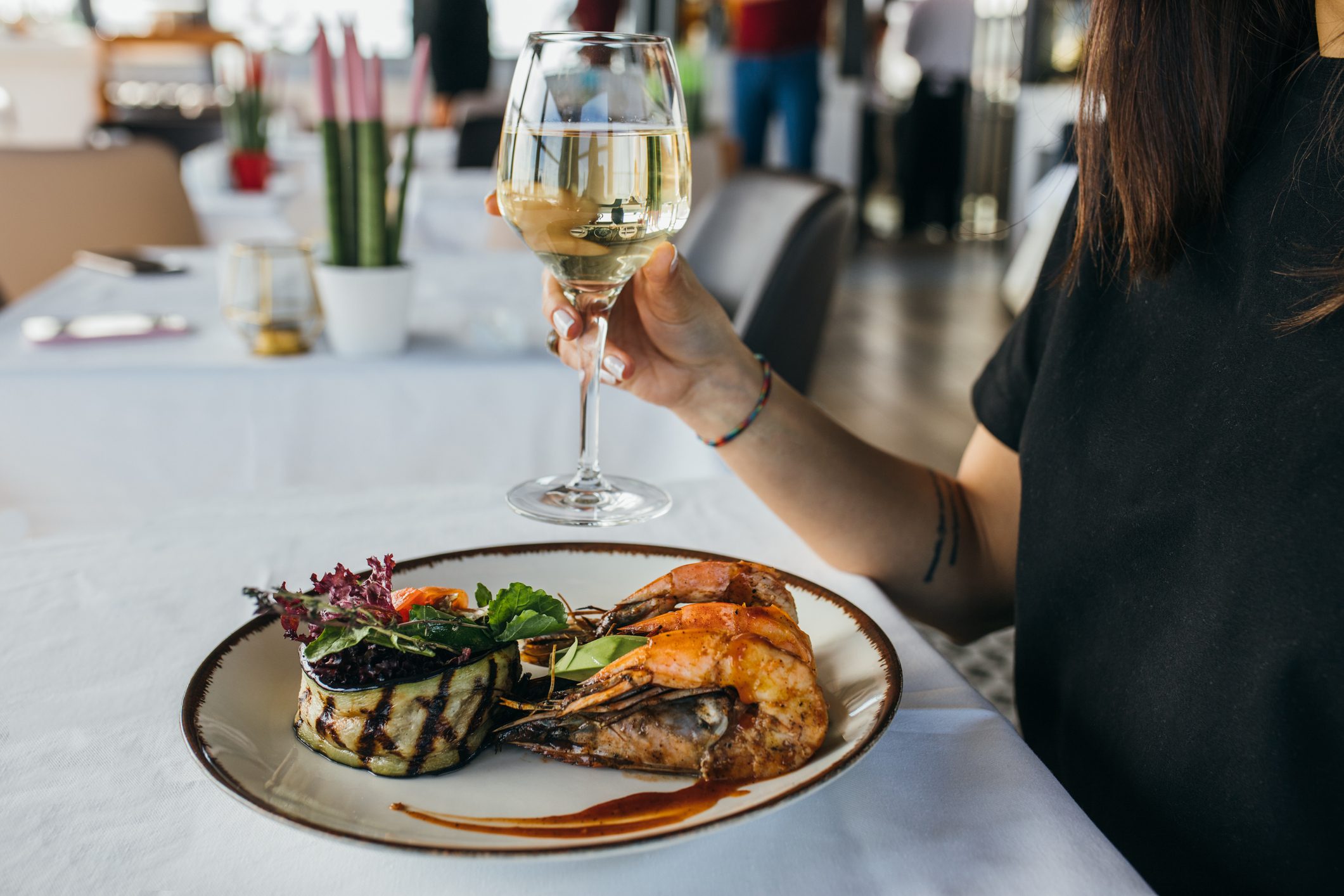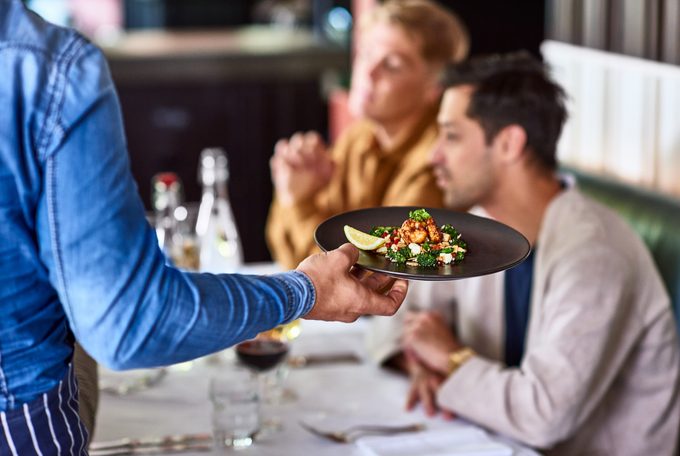Not satisfied with your meal? It's perfectly acceptable to (politely) send food back at a restaurant. Here's when and how to do it.

How to Send Food Back at a Restaurant Without Being Rude

In an ideal world, sending food back at a restaurant is a problem no one should have. When I worked in professional kitchens, there was not a single person that wasn’t trying their best, but just as in any other intense, fast-paced environment, accidents happened and mistakes were made.
“In the restaurant business, we strive to get every order correct, but mistakes do happen from time to time,” says David McIntyre, co-owner and operator of The Mash House in Westfield, Ind. “We’re all humans in the hospitality industry, and humans aren’t perfect. We understand when we’ve made a mistake, and we work very quickly to remedy it.”
Though I understand the pressure of working in the hospitality industry, I also know what it’s like to be served food that fell far below my expectations. Nobody goes out to eat to be disappointed! And the people behind your food truly want you to have a great meal, and a fantastic experience. Sending food back if you’re dissatisfied with your order is perfectly OK (and not inherently rude), but it’s important to follow etiquette rules when requesting a new dish or sending food back.
“When it comes to sending your food back at a restaurant, always be polite,” says etiquette expert Diane Gottsman. “Ask the server if the kitchen could please replace your overcooked steak or mushy pasta. Be pleasant, use a respectful tone of voice, and realize that it’s not the server’s fault.”
While there are plenty of habits restaurant staffers dislike, sending food back is acceptable, as long as you know the correct way to do it (and how to complain politely). As with all things, kindness is key. We interviewed a chef, an etiquette expert and a restauranteur to get their insight on how to send food back at a restaurant. Here’s what they told us.
Get Reader’s Digest’s Read Up newsletter for etiquette, humor, cleaning, travel, tech and fun facts all week long.
When is sending food back OK?
“Eating out should be an experience you look forward to and greatly enjoy, so it’s our duty as restauranteurs to ensure we keep up our end of the bargain and prepare your meal correctly,” says McIntyre. Sending food back at a restaurant should never become a regular habit, but there are some circumstances where it’s OK to send food back to the kitchen. Here’s when to do it.
If there was an error in preparation
In the fast-paced environment of a busy restaurant, it’s easy for small details to slip through the cracks. “It could be as simple as a server ringing in an order incorrectly, or a line cook missed something on the ticket,” says McIntyre. “So if you ordered your sandwich with no cheese but it came out with cheese, absolutely send it back.”
Sending food back is always acceptable if a special request was not followed, especially if it’s one involving food allergies. Remember that it’s a chef’s job to cook food the same way every time, so when things get busy, mistakes can happen—it’s not necessarily a sign of a bad restaurant. If your food isn’t prepared as you directed, or if there’s an ingredient on your dish that shouldn’t be there, alert your server right away and remind them of the preparation request you originally made.
Your food is cold
One acceptable scenario is if your food is noticeably cold—and it shouldn’t be. Your server can bring it back to the kitchen for the chef to heat it properly and make sure it’s brought to you at the correct temp.
Your food is cooked to the wrong temperature
Whether your veggies are still raw or your meat isn’t cooked as requested, sending your food back in this instance is warranted. If you asked for your steak medium-well, for instance, and it comes out rare, it’s perfectly acceptable to ask for it to be cooked further. Flag your server as quickly as possible so your food doesn’t get cold. Then, explain the situation. They’ll gladly have it cooked to your liking.
If your food is overcooked instead of undercooked, it’s still OK to ask politely if your meal can be remade. As long as you’re respectful, chefs are happy to fix the problem.
One caveat: If your meat is cooked only a few degrees more than what you prefer, you might not want to request a brand-new dish, especially at small local restaurants where margins are tight.
If you truly don’t like it
It’s a great idea to get out of your comfort zone when ordering at a restaurant. Dining out is a chance for chefs to impress you with their culinary skills. But everyone has different tastes, and what’s delicious to some might be questionable to others. If you find what you ordered to be truly unpalatable, it’s fine to send it back—just make sure you can offer up a reason, such as the seasoning is overpowering or the lemon sauce is too sour, and it may even help the restaurant in the future.
“Ultimately, we want the guest to be happy with their food choice,” says chef Amy Hessel of The Tilted Row in Baltimore. “Let your server know that you don’t care for what you ordered within taking a couple of bites. Ask if you can see a menu, and choose something you know you will like.”
What’s the polite way to send food back?

Now that you know all the instances when sending food back is acceptable, it’s important to know the correct way to do it—and the answer shouldn’t surprise you! Simply mind your table manners.
“If food is being sent back due to a mistake by the restaurant, there should be no animosity from the staff,” says McIntyre. “I would just remind people to be kind and courteous when sending food back; hospitality workers make errors just like the rest of us, so please don’t make them feel even worse.”
Speak up quickly
Make sure to flag down your waiter or a manager right away. You can wait until they visit the table after your first few bites, but don’t wait until others in your party have nearly finished their meal. Waiting too long to speak up not only delays your own meal, but can also cause tension with your dining companions.
“Try to be discreet with the server without alerting the entire table of guests, so it will not ruin the appetite of your dining mates,” advises Gottsman.
Be polite
“The most important thing to remember when returning food is to be polite to your server,” says Hessel. As long as you’re kind, respectful and remember to thank them for speaking to the chef or helping facilitate a new dish, no one will mind you sending food back to the kitchen. After all, the staff wants you to be happy.
Be patient
When everyone at your table is already digging in, it’s easy to forget that good food isn’t fast. “Be patient as the kitchen prepares a new meal for you,” says Hessel. “We start it right away, however we are often also working on several other tickets at the same time. We prioritize food that is being remade for a table, but it does take time to cook.”
When is sending food back not OK?
If you’re considering sending your food back, do it after one or two bites, not half the plate. “I feel it is not okay to eat the majority of your meal, and then decide to send it back,” says Hessel. “If there is a problem, alert your server or a manager as soon as you can to allow us to make things right.”
It should go without saying, but is also not okay to send food back in the hopes of recieving a discount or getting a free meal. Though every restaurant is free to set its own policy on the matter, most will not offer a refund or free replacement if more than half the dish has already been eaten.
And while some establishments might offer a slight discount or send out a free dish or drink as an apology, they are under no obligation to do so. A large restaurant chain might be able to absorb the cost of a discarded meal and a complimentary item, but small, independent restaurants run on razor-thin margins, and might not have the financial ability to offer freebies.
What happens to food when you send it back?
If meat is being sent back because it’s undercooked, a chef will likely cook it for a few more minutes until it’s at your desired level of doneness. Outside of that, most food that’s sent back to the kitchen goes straight into the trash.
“As the chef, first I check to see what the problem is,” says Hessel. “If something is over/undercooked, I check the temperature to confirm. If there is a problem with the taste of something, I will check to make sure everything was prepared correctly and that there wasn’t an error in making the dish. If the food is not simply being cooked further, we throw it out.”
“After an item has been sent back, it is always disposed of,” says McIntyre. After that, the kitchen will do their best to start preparing a replacement right away. But remember to be patient; the staff may take a little extra time cooking your dish to ensure it’s perfect, and if the restaurant is particularly busy, it might take a while.
About the experts
|
Why trust us
Reader’s Digest has published hundreds of etiquette stories that help readers navigate communication in a changing world. We regularly cover topics such as the best messages to send for any occasion, polite habits that aren’t as polite as they seem, email and texting etiquette, business etiquette, tipping etiquette, travel etiquette and more. We’re committed to producing high-quality content by writers with expertise and experience in their field in consultation with relevant, qualified experts. We rely on reputable primary sources, including government and professional organizations and academic institutions as well as our writers’ personal experience where appropriate. For this piece on sending food back at a restaurant, Allison Robicelli tapped her longtime experience as a food writer, cookbook author and chef. Then Jacqueline Whitmore, a business etiquette expert and hospitality consultant with more than 30 years of experience who owns the Protocol School of Palm Beach, gave it a rigorous review to ensure that all information is accurate and offers the best possible advice to readers. We verify all facts and data, back them with credible sourcing and revisit them over time to ensure they remain accurate and up to date. Read more about our team, our contributors and our editorial policies.
Sources:
- Amy Hessel, chef at the critically lauded The Tilted Row in Baltimore; email interview, December 2023
- David McIntyre, co-founder of The Mash House, the Stave Cocktail Lounge, and the West Fork Whiskey distillery in Indiana; email interview, Aug. 1, 2024
- Diane Gottsman, etiquette expert, author, speaker, popular media resource and owner of The Protocol School of Texas; email interview, Aug. 6, 2024























